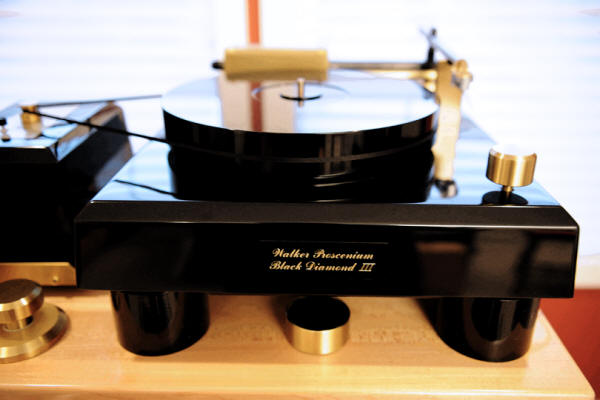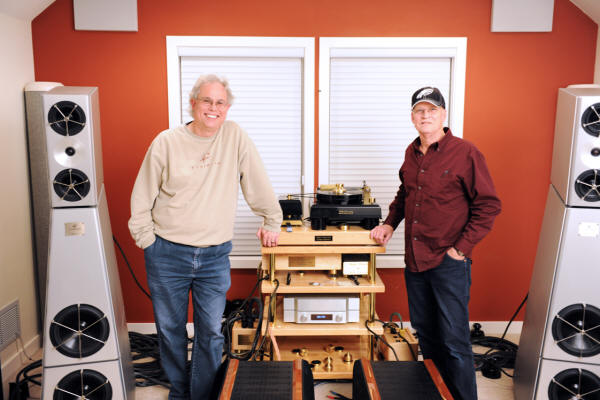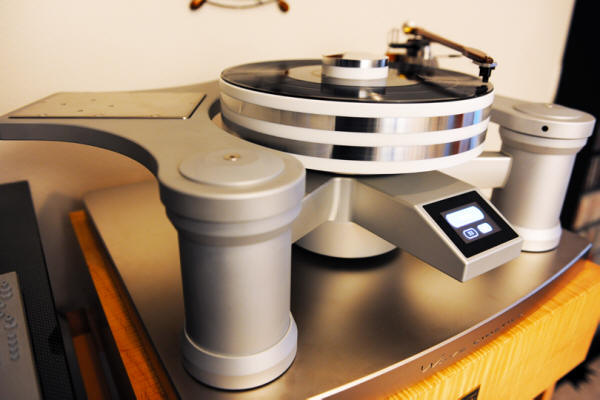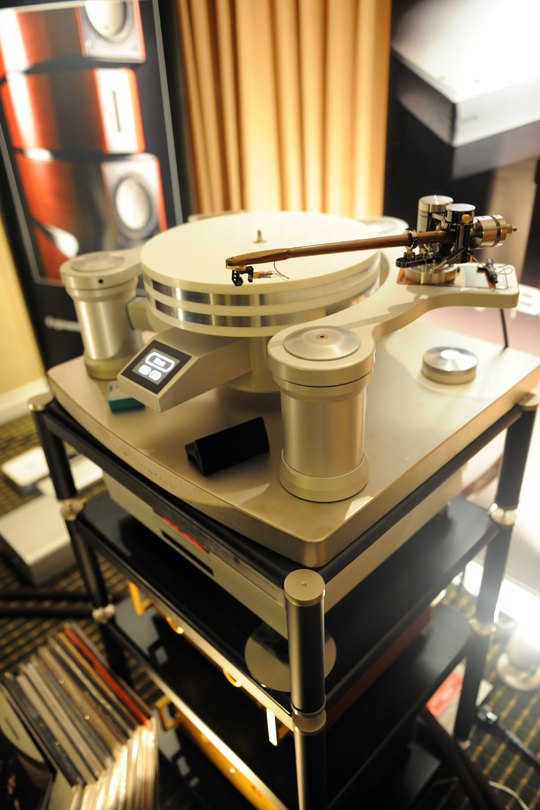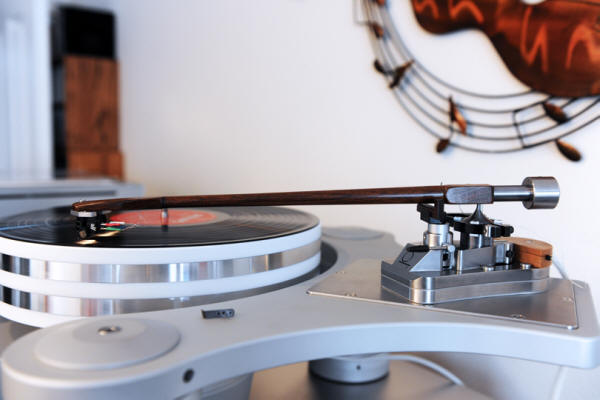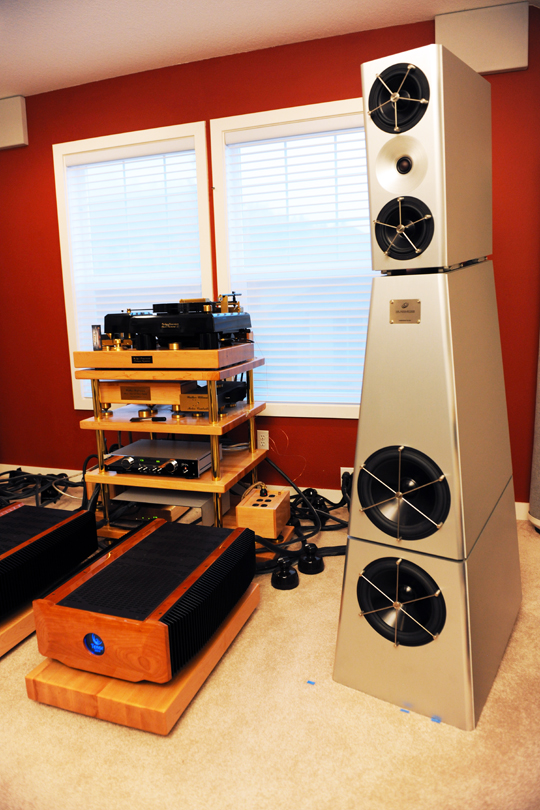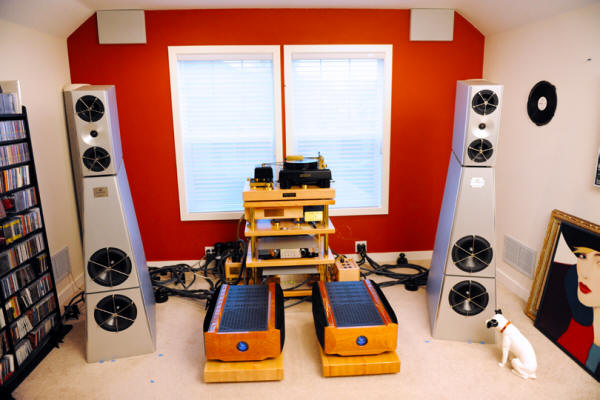|
You are reading the older HTML site
Positive Feedback
ISSUE
58
Impressions: My Brutus Awards for 2011, Part 1
[All images and processing by David W. Robinson, unless otherwise noted.] This has been an unusually rich year for some state-of-the-art audio designs in my listening room…in fact, a true embarrassment of riches for both digital and analog playback. It's also been a great year for desktop and computer-based systems. I've decided to break my PFO Brutus Awards for 2011 into two parts, both because there's so much to mention, and because it's a bit more logical that way. (2012, by the way, looks to be even heavier for new leading-edge audio designs… as I consider the logistics and the workload, I'm already feeling sorry for myself.) As always, I'll also be giving thought to anyone who might be up for my PF Life Achievement Award, and whether or not I heard anything that merits a PFO Circuitus Maximus Award. For those new to PFO, the Brutus Awards were establish back in 2003, when Dave Clark and I decided that the time had come to add Positive Feedback Online's voice to the world of audiophile awards. As I said last year (https://positive-feedback.com/Issue52/brutus.htm): After all, we weren't any less qualified than most of what was out there… heck, in some ways, we had a better take on what was good than some of the dreck that I saw. (Don't take that personally, unless I meant you... you know who you are.) In fact, I stated the rationale behind these awards back when we announced them in PFO Issue 10, December of 2003 (see Issue10). Just to be sure that my readers understand the rationale behind our Brutus Awards, I'll restate what I said then: We at Positive Feedback Online are going to have two main categories of annual awards. The first will be our Brutus Award. This will be recognition given to "the best and the brightest" products that we have experienced in various categories in a given year. In hardware, these will range from "best bang for the buck" to "the best period, and hang the expense!" designs. In recordings, we'll be paying tribute to the best that we've found in various formats. In addition, we'll have a "Lifetime Achievement Award" that will recognize individuals whose contributions to fine audio in various respects has been both superior and sustained. All products that are so recognized by PFO will be work that has been reviewed by us personally; no design will be recognized that we do not have experience with in our listening rooms. This means that you, our readers, may disagree with our selections, wondering why this or that component, recording or individual was not mentioned. Quite apart from differences in taste/opinion, the answer is simple: we won't be mentioning any design that we haven't spent time with in our own listening rooms. The idea is pretty simple: what are the really great components that I've heard in my listening room this year, whether I've completed the formal reviews yet or not? What are the great recordings and reissues? Who are the key people in fine audio? In addition, I added my Circuitus Maximus Award in 2009. This is how I introduced it last year: I have a new award that I am going to launch for 2009. This will be the PFO Circuitus Maximus Award. It will only be given when I've encountered multi-component systems that exhibit the very highest level of reference-grade synergy. Since that happens only once in a while, some years may see no Circuitus Maximus awarded at all. Finally, there is my PF Gizmo Award, for the best audiomanic of the year, the person who has gone over and above in design, tweakery, and Gizmological Gonzo Gonciousness. Some years I have a person who comes to mind; sometimes none. I do this award to honor my long-time audiobud, Harvey "Gizmo" Rosenberg, gone but not forgotten at this end. So now you know. Every year Dave Clark and I line up the best of the best that we've heard, and give you our choices. Part 1 of my list begins immediately… Part 2 will follow next week. Hardware In 2010, I spent a lot of time with computer-based, LAN-based, portable components, and desktop hardware. I noted that, "There was one major exception, which was the Playback Designs/darTZeel/Evolution Audio/Wave Kinetics system…" 2011 saw several major components arrive, with a better balance between listening room and computer/desktop systems. In fact, the results this year included some spectacular results, with designs that really pushed the envelope, and established themselves as absolutely front-rank and top-notch products. These included: Playback Designs MPS-5 SACD/CD player with USB-X Computer Interface and DSD/PCM system
In 2011, Playback Designs enhanced their reference SACD/CD player, the MPS-5, with the USB-X interface. This allows for USB to proprietary AUX input on the MPS-5; in conjunction with driver software for Windows 7 and a quick firmware update on the MPS-5, this system can handle PCM files out to 384kHz (!) and DSD signals in both single DSD 64fs (2.8224mHz) and Double DSD 128fs (5.6448mHz) rates (!!). I have spent quite a while with this system in my listening room, listening to PCM out to 192kHz/24-bit (both .WAV and .FLAC), and 64fs DSD files, all via USB 2.0 from a 2.0 TB Western Digital powered external HD. Even using beta software (in this case, Emotion from Merging Technologies) on an inexpensive Windows 7 i3-based notebook computer ($499), the results were smashing: high-resolution PCM files were very fine, while the DSD files that we have on hand here at PFO River City were killer! True reference-quality sound, without a doubt. In fact, I can't remember hearing better than this in my listening room…makes me wonder what Double DSD would sound like in here! (Notes on that just as soon as the next revision of the Emotion software package arrives.) If you're in the market for the best SACD/CD/high-resolution computer file system, this is it. Run…do not walk… and check out the Playback Designs MPS-5 with USB-X. This is a slam-dunk no-brainer Brutus Award winner for 2011: my very highest recommendation, with great enthusiasm! Playback Designs MPS-5 with USB-X: MSRP USD $17,000 Walker Audio Proscenium Black Diamond Level III Turntable
I have been the delighted owner of a Walker Audio Proscenium Black Diamond for over five years now. It has been a flawless performer in every regard, with sublime sound and no down time. Contrary to its reputation in some quarters, I can say definitively that the Walker Proscenium Black Diamond is anything but a "tweaky" turntable, by which I assume that some mean the Walker is too complex and drifts out of adjustment all of the time. Nothing could be further from the truth, in my experience. In the years that the Walker has been here, it has been rock solid, stable, steady, and has not required constant adjustment of any kind. The Proscenium Black Diamond is a highly adjustable turntable system, allowing for the finest tuning of all key parameters… even VTA micro-adjustments on an LP-by-LP basis, if you like. But once you've made an adjustment, you can go on for years with that setting… unless your house is settling! Take my word for it: the Walker is very adjustable, but not hard to deal with, and it is as solid and steady as the proverbial rock. Reports to the contrary are not credible, because they do not match my experience. Enough of that. Lloyd and Felicia Walker came out recently to upgrade my Walker turntable to the Proscenium Black Diamond Level III. This represents the current sum of Lloyd's design genius with his configuration. As you may recall, I described the setup and design assumptions way back in PFO Issue 23, January/February of 2006 (see https://positive-feedback.com/Issue23/proscenium.htm). Lloyd's system can be summed up as a massive (i.e., the deliberate use of significant mass for vibration/sonic control), belt-driven, clamped (not vacuum hold-down), air suspension system, with a linear-tracking air-suspended tonearm, and very fine adjustability in all key playback parameters. In the upgrade to Level III, he completely re-worked the air pressure system for the air suspension. Instead of having a two-way system, with different pressures and feeds to the platter (4-5 psi) vs. the rest of the system (45-50 psi), he has created a three-way system, with pressures of 4-5 psi for the for the platter, 21.5 psi for the air suspension for the turntable, and 45-50 psi for the linear-tracking tonearm. A new pressure gauge is now present on the in-room air pressure isolation chambers, to monitor the feed to the He also upgraded the air supply system with an automatic solenoid control on the air filter system, and installed new air suspension pods and couplers under the turntable.
Editor David Robinson with Lloyd Walker of Walker Audio after the successful completion of the Level III upgrade project… world-class, first-rank analog sound! The results have been nothing less than spectacular. The noise floor was further improved, transparency heightened, and detail retrieval enhanced. The dynamics are noticeably even better than before (and "before" was exceptional). I also note that the soundstaging was somewhat deeper than before, further out through the wall than before. I found the overall effect to be a unique combination of resolution and an organic harmonic structure. Sounds strange, but there it is. Apparently, the use of the radically different suspension pressure brings out more detail from the grooves, and yet does so without drifting over into an analytical sound. Impressive! No doubt about it, the Walker Audio Proscenium Black Diamond Level III turntable system is more of everything that it has excelled in; this major upgrade has upped the reference standard at the very tip-top in the world of fine audio turntables once again. Another slam-dunk for Walker Audio…and a 2011 Brutus Award to prove it! My very highest recommendation… again, with enthusiasm! Walker Audio Proscenium Black Diamond Level III turntable: MSRP USD $89,995 Upgrades to older Walker turntables are available; contact Walker Audio for a quote. Walker Audio "The Eliminator" EMI/RF Directional Antennae While I'm talking about Walker Audio, I must also mention a new accessory at the other end of the price range. Lloyd Walker sent me a sample of a simple new tweak that he's developed to drop interference from RF. Called "The Eliminator," it's a spade connector with a bare solid silver wire attached. Used on the back of your amplifier, it attaches to the negative (-, color-coded black) binding post. It is placed between the speaker cable and your binding post nut. The soldered side of The Eliminator faces the speaker cable; the smooth side should be facing the binding post nut. The cables should be bent 90 degrees upwards at the post, as if they were antennas. Be very careful not to let The Eliminator touch your + binding post or the cables thereof. If you want extra protection against blown fuses, use the supplied Teflon wire cover to slide over the wire; bend the end 90 degrees at the very far end of the cable to keep the insulator in place. I've tried them; these little wonders do actually reduce RF, which, in my listening room at an elevation of 750 feet, and not too far from radio transmission towers, is a real problem. "After" with The Eliminator in place was definitely better than "before." If EMI/RF are problems where you are, then you'll want to consider this very handy tweak. Simple and effective, recommended… and a 2011 Brutus Award winner. Walker Audio The Eliminator EMI/RF Directional Antennae: USD $275/pair. Wave Kinetics NVS Direct-Drive Turntable and Isolation Stand with Durand Telos 12" Tonearm and Ortofon A90 MC cartridge
Coming at reference-grade turntable design from an entirely different vector is the Wave Kinetics NVS. It arrived very recently in my listening room, together with the Durand Telos 12" tonearm. To that we added the Ortofon A90 MC cartridge, a "known good." The design incorporates a relatively compact footprint, though its weight is still quite substantial. The NVS is a computer-controlled direct-drive turntable, with a touch screen to control speeds (33.3 and 45 RPM) and start/stop, with a screw down clamp, and a thick multi-strata platter. It's three adjustable pods support the mass of the unit, which in turn rests upon a remarkable Wave Kinetics isolation platform that is included with the turntable.
Due to the precision of the computer control module for the direct-drive motor, the turntable is extraordinarily linear in its speed control, and thus its pitch accuracy. Operation is completely silent; I don't remember a quieter turntable in my listening room.
The Durand Telos tonearm is the first 12" arm that I've had here. Designed and executed by Joel Durand, it is a thing of beauty, a real work of art. Constructed of wood and custom machined brass and stainless steel and other cool stuff, the Telos takes to the NVS and synergizes as if they were born twins. And when you put the superb Ortofon A90 MC into the mix…well, the results are spectacular. Since this system arrived late in the year, further commentary will have to follow in 2012. Rest assured, however, that the Wave Kinetics NVS/Durand Tonearms Telos/Ortofon A90 is one of the truly wondrous combinations that I've ever heard. Definitely at the very top level of turntable systems on the planet, and thus worthy of one of my Brutus Awards for 2011, and my very highest recommendation, with great enthusiasm! The Wave Kinetics NVS with isolation platform: MSRP $45,000 Durand Tonearms Telos: MSRP $14,500; sold only factory direct (for more on the Telos, go to http://www.durand-tonearms.com/Telos/thetelos.html). YG Acoustics Anat III Professional Signature Loudspeaker, Tenor Audio 350M Monoblock Amplifiers, & Kubala-Sosna Elation! Cables
For the past few months I've been blessed with an daily experience of another wonderful synergistic blend: the combination of Yoav Geva's brilliant YG Acoustics Anat III Professional Signature loudspeakers, driven by the exceptional Tenor Audio 350M monoblocks, and cabled with Kubala-Sosna's reference line, the Elation! I first heard the possibilities of this combination at shows beginning at RMAF in 2010, and tracked it into 2011. The good folks at YG, Tenor, and Kubala-Sosna worked with me to synchronize the logistics so that we could actually have them all here in the same place at the same time… thanks to Yoav Geva, Dick Diamond, Jim Fairhead, Joe Kubala, and Howard Sosna for all of the help! The results have been truly brilliant; as I've listened over the last several months, the combination of detail, musicality, dynamics, and precise imaging and soundstaging have been most impressive. Each of these products is a no-holds-barred assault on the state of the art in fine audio, but the combination of them is greater than the simple sum of the parts. There is something going on here that sounds like a fusion of audio vision, and an agreement about musical values.
Whatever it is, the results place this tandem in the top rank of audio systems that I have heard. My final review comments will come in the first quarter of 2012, but I can already say that this is absolutely worthy of one of my Brutus Awards for 2011; at the risk of sounding redundant: my highest recommendation, with great enthusiasm! YG Acoustics Anat III Professional Signature Loudspeakers: MSRP USD $119,000/pair Tenor Audio 350M Monoblock Amplifier: MSRP USD $100,000/pair Kubala-Sosna Elation interconnects, speaker cables, and power cables: varies; contact the manufacturer or your local dealer for a quote. [End of Robinson's PFO Brutus Awards for 2011, part 1. Part 2 will follow next week.]
|
|
|


